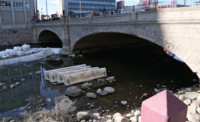
In St. Louis, a half-dozen public agencies teamed up with scores of private donors to fund the $380-million CityArchRiver 2015 project. One of the agencies is the Great Rivers Greenway District, created by St. Louis voters in 2000, with a mandate to connect and integrate the iconic 630-ft-tall, 630-ft-wide Gateway Arch with downtown.
In Kansas City, voters approved in 2012 a transportation development district consisting of public and private interests to build a $102-million 20-mile streetcar project. The goal: Connect growing areas of the city to downtown.
In Denver, the Rapid Transportation District and the Colorado Dept. of Transportation gave the Low & Slow team tours of their two-phase, $2.2-billion Eagle project. It is designed to create the state's first truly multimodal corridor, including upgraded, untolled highway lanes; a tolled HOV lane in each direction; bus rapid-transit service; and a paved, off-highway bike lane that runs parallel to U.S. 36 from Boulder to Denver's north metro area. It is CDOT's first use of public-private partnerships, P3 transit components and P3 toll-lane expansion of US 36. And yes, the goal is to connect growing areas of the city with a booming downtown.
At the two-third's mark of ENR's Low & Slow cross-country journey across U.S. infrastructure, a theme kept echoing: Public agencies are cobbling together their meager pots of funding to get the most out of each dollar—while answering even more directly to voters who made key projects possible.
"It's an exciting time to be in public works," says John McCarty, president of the Colorado chapter of the American Public Works Association. Noting the willingness of voters to tax themselves for desired projects, he added: "You have to tell voters exactly what they're going to get and when, so that when the time comes to renew the tax, they'll say yes."
George Delaney, chief operations officer of the Denver Dept. of Public Works, notes that ongoing rail work in the city provides auxiliary opportunities to improve other infrastructure, such as signals, drains and mains. "Different agencies are recognizing cross-needs," he says. "The silos are breaking down."
Such is the case with the Kansas City streetcar project, where the construction has spurred city officials to replace water and sewer lines more than 100 years old along the route, says Sherri McIntyre, Kansas City public works director. The water and sewer companies are contributing $12 million to the approximately $25 million worth of improvements. Moreover, the transportation district agreed to take on the upgrade and maintenance of two bridges along the alignment from the cash-strapped Missouri Dept. of Transportation.
In St. Louis, the use of matching funds helped get the archway project out of the gate. MoDOT obtained a $20-million TIGER grant in 2004 and contributed a matching fund, says Ryan McClure, spokesman for CityArchRiver 2015. In 2013, voters in St. Louis County and St. Louis City approved Proposition P, which added another 90 million.
Private donations raised $221 million for the project, which includes extending the park over Interstate 44 to the downtown courthouse, elevating the riverfront boulevard, expanding the existing museum by 46,000 sq ft and replacing a parking garage with seven acres of park.
Back in Denver, the FasTracks officials work hand-in-hand with both the airport and the CDOT. The airport station, a component of the 22.8-mile East Rail Line that is part of a $2.2-billion P3, entailed a 1.2-million-cu-yd excavation 30 ft deep to build tracks and an 800-ft-long platform connecting to the new Denver airport hotel.
FasTracks also contributed $136 million to CDOT's $497-million US 36 project. It will create the state's first multimodal corridor, including tolled HOV lanes, a parallel bike lane and FasTracks bus rapid transit ramps and ability to use shoulders as lanes if needed.



Post a comment to this article
Report Abusive Comment